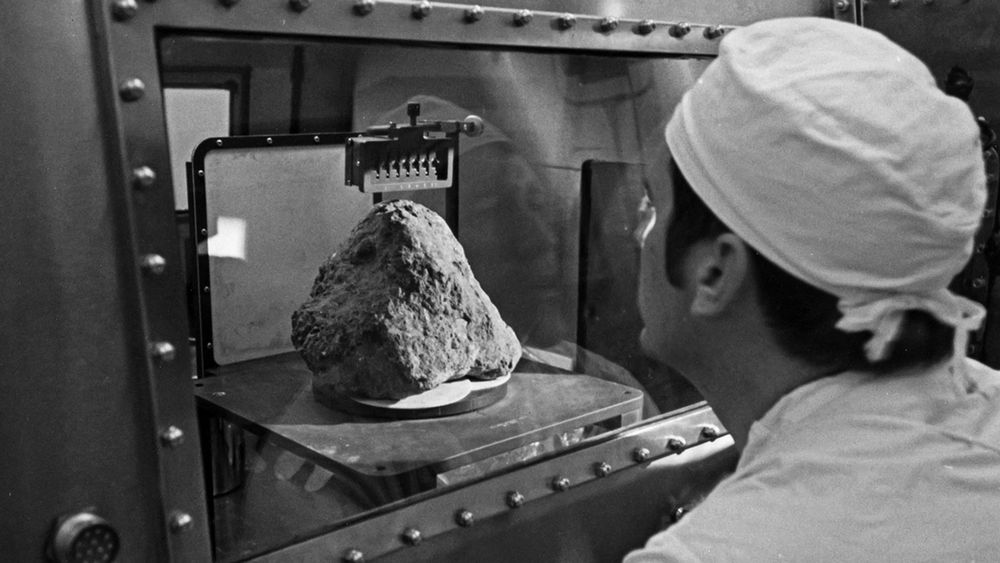The six Apollo missions that landed on the moon from 1969 to 1972 brought back several hundred kilograms of rocks from the lunar surface. Scientists have been studying these moon rocks for decades to learn more about the geology, minerology, impact history, and magnetic environment of the moon. Some of these studies have produced interesting results, such as the one involving a big rock sample known as “Big Bertha”.
“Big Bertha” was the largest sample collected by the Apollo 14 astronauts that landed on the moon in 1971. It was recovered from the edge of a small impact crater called Cone, and weighed 9 kilograms. It was nicknamed “Big Bertha” after the famous large World War I German howitzer, because at that time it was the largest lunar rock ever recovered.

A scientist analyzing the rock sample “Big Bertha”. Photo: NASA
When Big Bertha was cut open, scientists found a clast of granite containing two zircon grains in a complex breccia. Zircon is one of the key minerals used by geologists for radiometric dating. Because zircons can survive geologic processes like erosion, transport, and even high-grade metamorphism, they contain a rich and varied record of geological processes such as the time, temperature, pressure, and geochemistry when they formed. The zircons from Jack Hills in Western Australia, have been dated to 4.4 billion years old, making them the oldest minerals so far dated on Earth.
Past studies have shown that these two lunar zircons are also ancient—about 4.1 billion years old—and formed during a tumultuous time in the solar system’s history called the Late Heavy Bombardment. During this early period of formation of the solar system, approximately 4.1 to 3.8 billion years ago, a disproportionately large number of asteroids collided with the early terrestrial planets in the inner Solar System, including Mercury, Venus, Earth and Mars. Scientists originally thought that Big Bertha, along with the other samples collected during Apollo 14, is lunar debris from an impact that formed Mare Imbrium. But a 2019 study seems to suggest that the two zircons were born even farther away, on Earth.
Dr. Bellucci, a geochemist and professor at the Department of Geosciences of the Swedish Museum of Natural History in Stockholm, found that the minerology of the rock sample is similar to that of granite, which is extremely rare on the Moon but common on Earth. It also contains quartz, which is an even more unusual find on the Moon.

“Big Bertha” on the lunar surface prior to collection. It is the rock exactly at the center of the photograph. Photo: NASA
David Kring, a lunar geologist at the Lunar and Planetary Institute in Houston, who also studied the samples brought by Apollo 14, says that the results indicate that the rock formed in a water-rich environment at temperatures and pressures corresponding to either 19 kilometers beneath the surface of Earth, or about 170 kilometers deep in the moon. The researchers prefer to believe that the samples came from Earth, rather than from a tremendous depth that is way below the moon’s crust.
The team believes that the rock formed on Earth’s surface about 4 to 4.1 billion years ago, and then excavated by a large meteorite impact that sent it hurtling into space towards the moon, which was three times closer to Earth than it is today. Once the sample reached the lunar surface, it was affected by several other impact events, one of which partially melted it 3.9 billion years ago, and which probably buried it beneath the surface. Finally, about 26 million years ago, another meteorite impact excavated the sample back onto the lunar surface, where astronauts collected it almost fifty years ago.
If the rock is indeed terrestrial, Kring said that it can provide valuable information about the early stage of formation of the Earth, known as the Hadean eon. Big Bertha shows that Earth was impacted by asteroids massive enough to produce new meteors, and granitic rocks that make up Earth's continents were already forming. Elizabeth Bell, a geochemist at the University of California, noted that the Moon might be a better place to look for ancient Earth rocks than Earth itself, as material erodes much slower on the Moon's surface than it does on Earth. Big Bertha's identification as an Earth-originated meteorite, according to Kring, may drive other scientists to examine Apollo lunar samples.
Only a small fraction of the 382 kilograms of rocks brought back by the astronauts have been studied so far, but analytical techniques are constantly improving so there is still more to learn.
References:
# Terrestrial Meteorite Found on the Moon, Sci News
# Ancient Earth rock found on the moon, Science
# Apollo May Have Found an Earth Meteorite on the Moon, EOS












Comments
Post a Comment